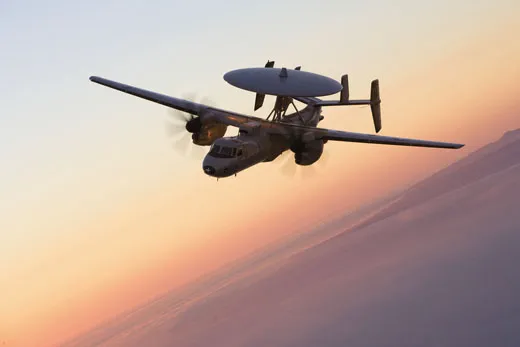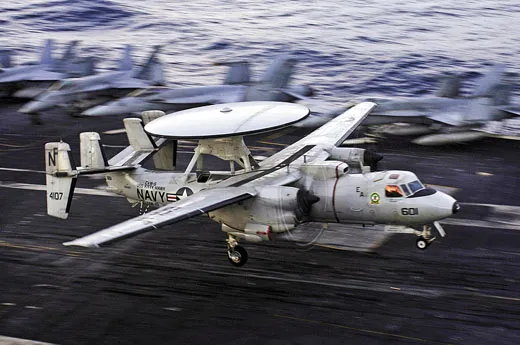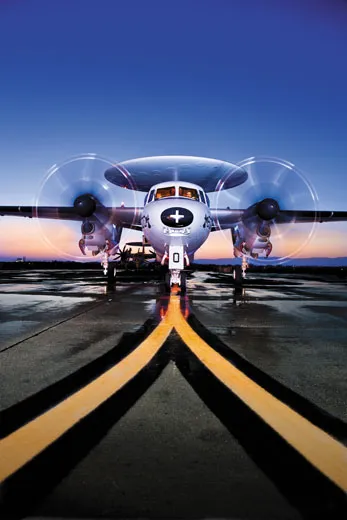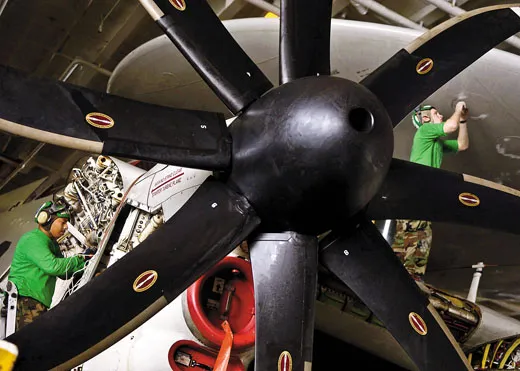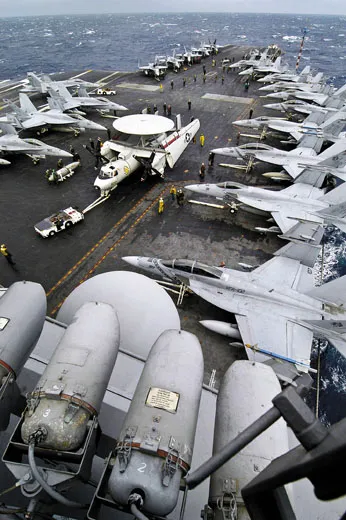Detect and Direct
The Navy’s newest Hawkeye gets closer to the fight.
/https://tf-cmsv2-smithsonianmag-media.s3.amazonaws.com/filer/hawkeye-631.jpg)
Commander Herb Carmen is the executive officer of VAW-116, a U.S. Navy squadron that flies four E-2 Hawkeyes. But at the moment, 15 seconds from a carrier landing training exercise at Point Mugu Naval Air Station, Carmen looks less like a pilot on final than a circus performer juggling swords and chainsaws—feet dancing on the rudder pedals, eyes darting between instruments and environment, left hand working the yoke while the right gooses the throttle as the airplane lurches through turbulent skies off the California coast.
E-2s, the electronic eyes of the fleet, have been in production longer than any military airplane in U.S. history. That is the great irony of the Hawkeye. Although the airframe first flew almost 50 years ago, the E-2C plays a uniquely pivotal role in the fighting doctrine of today’s modern military. Yes, it was conceived as an airborne early-warning aircraft to keep the fleet safe while steaming in unfriendly waters. But its powerful array of radars and communications devices makes it a perfect weapon for modern network-centric warfare, and it’s turned out to be almost as useful for ground operations—and for foreign air forces—as it is for its original purpose.
“We’re like the guys who climb up on top of a hill and see what’s going on down below,” says Randy Blackmon, the commanding officer of VAW-116. “We’ve got a God’s-eye view of everything that’s happening. So as the E-2 goes, so goes the mission. We’ve seen that again and again, and not just during training. At the start of Operation Iraqi Freedom, a lot of guys were bringing bombs back to the boat [after failing to find targets during combat sorties]. Then E-2s started getting into the party, and they started putting two and two together, hooking up people with targets.”
Carmen’s E-2C Hawkeye 2000 lands at a relatively sedate 140 mph, so the pucker factor doesn’t rise to F/A-18 levels. But unlike the Hornet, the Hawkeye isn’t equipped with digital flight controls, so it has to be flown by a pilot rather than a computer. Further complicating matters, it’s the biggest bird in the carrier air wing, with a wingspan that permits only four feet of deviation from the centerline of the carrier's flight deck. Also, to minimize the parts inventory, both of the Hawkeye’s propellers spin in the same direction, so whenever power is adjusted, the airplane yaws. And, thanks in part to the droopy four-tip tail section (a product of an aircraft carrier’s height restrictions and aerodynamic anomalies caused by a 24-foot-wide rotating radar dome that sits like a mushroom atop the fuselage), pitch is super-sensitive to throttle inputs. So every carrier landing is something of a spectacle.
With the E-2 sinking at a rate of 500 feet per minute as it approaches the simulated carrier deck (actually Point Mugu’s Runway 27), Lieutenant Mike Vogel, manning the radar scopes in the back of the airplane, warns me over the radio: “This isn’t an airliner. My advice is to clench your teeth when we land so you don’t bite your tongue.” Carrier landings don’t allow for niceties such as flaring before touchdown, so the Hawkeye slams down, successfully “trapping” an imaginary three wire. (Aircraft carriers have four arresting wires, but the three wire is the one pilots try to catch with their tailhooks.) Carmen applies full power, then eases back on the yoke, and the airplane effortlessly wings out over the Pacific for another touch-and-go.
“It’s pretty peppy for a prop plane,” says Carmen. He’s got 2,400 hours in Hawkeyes, so it’s understandable that he trumpets their performance. “I know it’s not the sexiest aircraft on the flight deck. But the guys who carry weapons and drop bombs couldn’t do what they do without us. The E-2 is like the quarterback of the fleet. The Hornets and Prowlers are the wide receivers and the running backs. They’re the ones who score the touchdowns. But if the quarterback doesn’t perform well, they don’t perform well either.”
An E-2’s pilot and copilot earn their pay, especially during night carrier landings. But the heavy lifting in a Hawkeye is done by the three naval flight officers, known colloquially as tube monkeys, who man a trio of 21-inch computer screens in the back end of the airplane. While an E-2C loiters at high altitude, they use their radar to monitor what’s going on in the entire theater and to zoom in on specific areas. But in addition, their extensive communications systems—conventional radios, satellite units, data-links, even text-messaging—allow them to stay in touch with all relevant units on land and sea, in the air, and under water. Not for nothing is the senior naval flight officer called the “mission commander”; he might well know more about the battlefield situation than anybody in the fight.
“The E-2 is in many ways the centerpiece of modern carrier aviation,” says Commander Richard Weathers. Now head of the Navy’s E-2C weapons school, Weathers was the executive officer of VAW-115 during the invasion of Iraq in 2003, when he and his commanding officer convinced the air wing commander to send Hawkeyes over land to coordinate ground-support and interdiction missions. “Once we were able to get close enough to the fight, our strike aircraft started coming back ‘clean wing’—without any bombs,” says Weathers. “Today, I believe, any strike group commander would consider it unthinkable to go into battle without an E-2.”
One of the greatest limitations of radar is that it operates by line of sight. The most obvious solution is to elevate the radar above the curvature of the earth. Hence the development of airborne early-warning aircraft, starting in World War II with a Grumman Avenger torpedo bomber retrofitted with radar to protect Navy ships from kamikaze attacks.
The E-2 first flew in 1960, joining the Navy fleet in 1964. The Hawkeye is dwarfed by the U.S. Air Force’s Boeing E-3 Sentry airborne warning and control system aircraft, which performs a similar function, albeit with a much larger crew. Because the E-2 has to fit on an aircraft carrier, the Hawkeye’s wingspan tops out at 80 feet, 7 inches. Over the years, E-2s have been fitted with several generations of T56 turboprop engines, originally built by Allison and now by Rolls-Royce. The Hawkeye 2000 is equipped with a pair of T56-A-427 engines rated at 5,100 shaft horsepower apiece.
Until recently, the E-2’s engines sported wicked four-blade props, which generated a hellacious racket (imagine an unmuffled Harley-Davidson running through a stack of Marshall amps). The noise (and destructive power) of the props made the E-2 a fearsome presence on the flight deck and inspired the nickname “the Hummer.” Now fitted with fuel-efficient eight-blade props that are gentler on E-2 airframes, the airplane sounds more like a giant swarm of super-sized bees. “Not only is the eight-blade propeller quieter, but it’s also a lot smoother,” says Lieutenant Jon Gathman, a VAW-116 naval flight officer. “When you came back from a four-and-a-half-hour mission with the four-blade, you used to be exhausted from all the vibration it had put on you.”
Although the fundamental airplane hasn’t changed for nearly half a century, the E-2 has gone through a long and complicated series of model changes driven by electronic upgrades, most notably to the radar. Even in the unlikely event that you miss the huge rotating radar dome, you’d recognize the E-2’s raison d’être the instant you climbed inside. The belly of the starboard fuselage is crammed with radar gear. Snaking through riveted boxes are tubes of the exotic vapor-cycle cooling system required to keep the electronic units at safe temperatures. The cooling system is so important that monitoring it is a primary flight responsibility of the radar operator, the most junior of the Hawkeye’s three naval flight officers.
Walk (hunched over) back past the radar gear and you reach the “office” of the Hawkeye, a cramped space bristling with buttons, switches, gauges, and computer screens. Here the three naval flight officers sit line astern for takeoff, then swivel their seats 90 degrees to the left to face their radar scopes and communications displays. The high-power UHF Doppler radar is able to monitor six million cubic miles and track 20,000 targets simultaneously, keeping its operators tolerably busy.
Although the pressurized cabin is a mask-free environment, the naval flight officers continue to wear their bulky flight gear and remain strapped to the heavy parachutes that are integrated into their seats. Fortunately, their workstations feature metal trays that slide out to expose keyboards and built-in trackballs. The close quarters also allow the naval flight officers to pass notes, communicate by hand signals, and, when things get crazy, even operate each other’s equipment. “We get so much information coming through our scopes and the radios that it’s easy to lose track of what the airplane itself is doing,” says Lieutenant Commander Carl Whorton, who saw action over Afghanistan.
Case in point: During the push toward Baghdad, Carmen was flying an E-2 in a night mission over Iraq when he saw a shower of sparks rush past the cockpit: an Iraqi missile. He banked violently to the left and went to full power. A naval flight officer in the back end got on the radio, supremely annoyed and wondering what the hell was going on. “When we told them that we’d gotten shot at, he didn’t believe us, and he said something like, ‘Yeah, right,’ ” says Carmen. Only after much heavy breathing and expletives undeleted was the truth accepted. Says Carmen: “Even as we were flying that night, I remembered a Churchill quote: ‘Nothing in life is so exhilarating as to be shot at without result.’ ”
Every carrier air wing includes a four-Hawkeye squadron. Typically, an E-2 is the first airplane to launch and the last to land. For a classic airborne early-warning mission, it takes up station high above the fleet. The mission commander, known as the CICO, or combat information center officer, is the naval flight officer sitting in the middle seat. His radar scans 300-plus miles to identify threats, and he’s in radio contact with the air defense commander, usually stationed on an Aegis missile cruiser. If he gets a radar hit that isn’t squawking (sending out aircraft-identification signals from an onboard transponder), the E-2’s air control officer, who sits in the back seat, zooms in on the inbound track and radios the Hornets doing combat air patrol duty.
Because the E-2 was originally designed for seagoing missions, its radar has trouble filtering out clutter on land and objects skimming over the ground, such as cruise missiles and helicopters. To enhance the Hawkeye’s flexibility, Northrop Grumman is developing an E-2D, with an APY-9 radar system that dramatically improves clutter rejection while expanding search volume by 250 percent. Also, unlike the current antenna, which scans 360 degrees every 10 seconds, the new one can pause to lock onto targets, which will provide the radar operators with even more information to digest. To spread the workload, the new design gives the copilot a scope of his own so he can participate in the E-2’s tactical mission when he’s not helping fly the airplane.
“We’re no longer a blue-water battle-group Navy,” says Captain Randy Mahr, the E-2 program manager. “We’re now a Navy that operates much closer to land, so we’ve expanded the E-2’s mission and designed it to be supportable through the middle of the 21st century.”
Shortly after the 9/11 terrorist attacks, Whorton was flying as the air control officer with VAW-117, the Wallbangers, when he heard a chilling radio call from a ground controller in Afghanistan.
“Banger, I have troops in contact,” said the controller, who authenticated his identity as American by providing Whorton with the proper security codes. “Require assets immediately.”
“He was very calm,” Whorton recalls of the controller, whose name and military branch remained unknown. “But every time he keyed the radio, I could hear incoming fire.”
Whorton relayed the news to his combat information center officer. Though Hawkeye naval flight officers are unable to see targets and activity on the ground, they have a line on all the airplanes in the area: current position, assigned target, weapons, fuel status, and so on. At the moment, a pair of Hornets armed with GBU-12 laser-guided bombs were coming off a tanker and the two other F/A-18s in the division were about to refuel. After getting an okay from his combat information center officer, Whorton dispatched the fighters to provide urgently needed close air support.
After radioing orders to the Hornets, Whorton watched four friendly aircraft symbols cross his radar screen. A few minutes later, he got a call from the lead Hornet: “We’re Winchester [out of ammunition] and RTB [returning to base],” the pilot reported.
“Do you require additional assets?” Whorton asked the ground controller.
“Negative. I’m very good right now,” came the radioed reply, which was no longer competing with the sound of incoming gunfire. “Have a good day.”
“I felt really good about that,” Whorton says. “We’re not frontline guys. But it was good to know that, after all of our training, my job made a difference and we were able to help the guys who were under fire. The system worked the way it was supposed to.”
The Hawkeye, of course, wasn’t designed for close air support, but time and again during the fighting in the Gulf, ground troops advanced so rapidly that they passed beyond radio contact with the units that were supposed to coordinate close air support for them. Early on in Iraq, E-2s were pressed into a stopgap role as airborne communications relays between ground forces and the U.S. Army’s Air Support Operations Center. But because the battleground was so fluid and so many airplanes had to be re-routed so quickly, Hawkeyes were given more latitude to pair warfighters with targets.
“If the Hawkeye hadn’t been there, I think the [Air Support Operations Center] would have failed,” says Lieutenant Commander Brent Trickel, an E-2 naval flight officer who served as the Navy’s only officer in the Air Support Operations Center during the first few weeks of the war. “It would have been shut down. I don’t think you’ll find a more flexible platform than the Hawkeye.”
These days, in addition to traditional airborne early-warning duty, Hawkeyes are being asked to push their noses closer to the fight to coordinate ground attacks and close air support. Theoretically, these missions ought to be covered by the daily Air Tasking Order, which details every sortie to be flown that day. “But everything never goes exactly according to the ATO, which is why you need an E-2,” says Weathers. Targets move. Attacks are launched unexpectedly. Engines go sour. Bombs fail to explode.
For many years, the E-2 was naval aviation’s version of the pleasant girl in high- school who was everybody’s friend but never got asked to the prom. Light on sex appeal, the Hawkeye was ignored by the fighter jocks, who, as the expression goes, like to fly at 1,000 miles per hour with their hair on fire. Times have changed. The E-2 has shown what it can do in shooting wars, and as members of the Hawkeye community have risen in the naval hierarchy, the airplane’s reputation has gone up accordingly. “We go through training exercises side by side with [Hornet pilots], so they’re used to us,” says Carmen. “They know that we understand how airplanes fly—that they can’t turn on a dime or fly without fuel. So they like hearing from us. We’re like an extension of them. We just fly slower than they do.”
For now, the Navy plans to start retiring its E-2Cs in 2013, when the first of the new E-2Ds are scheduled to reach carrier squadrons. (Mexico, France, Egypt, Japan, Taiwan, and Singapore also fly Hawkeyes, but so far none of them has placed an order for the E-2D.) D models will look almost identical to their predecessors, and they should carry the E-2 well into its senior years. “I’m looking forward to the E-2E,” says Northrop Grumman vice president Tom Vice. “And there are plenty of other letters in the alphabet after that.”
